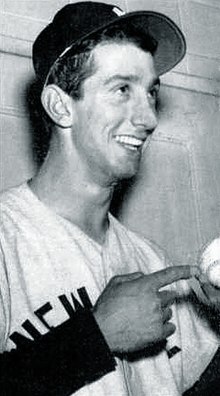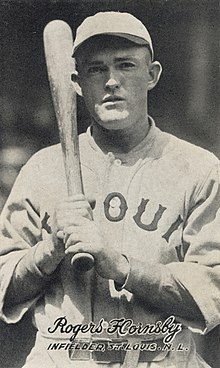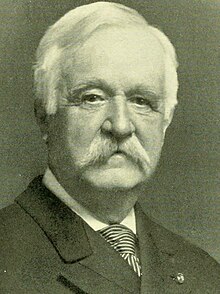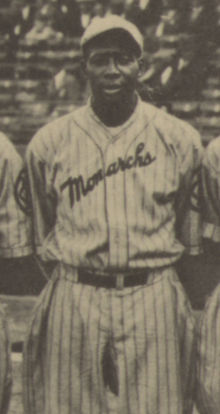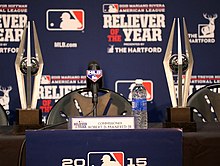Portal:Baseball
Portal maintenance status: (June 2018)
|
| Main page | Content, Categories & Topics | WikiProjects & Things you can do |
The Baseball Portal
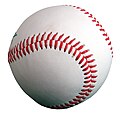
Baseball is a bat-and-ball sport played between two teams of nine players each, taking turns batting and fielding. The game occurs over the course of several plays, with each play generally beginning when a player on the fielding team, called the pitcher, throws a ball that a player on the batting team, called the batter, tries to hit with a bat. The objective of the offensive team (batting team) is to hit the ball into the field of play, away from the other team's players, allowing its players to run the bases, having them advance counter-clockwise around four bases to score what are called "runs". The objective of the defensive team (referred to as the fielding team) is to prevent batters from becoming runners, and to prevent runners' advance around the bases. A run is scored when a runner legally advances around the bases in order and touches home plate (the place where the player started as a batter).
The opposing teams switch back and forth between batting and fielding; the batting team's turn to bat is over once the fielding team records three outs. One turn batting for each team constitutes an inning. A game is usually composed of nine innings, and the team with the greater number of runs at the end of the game wins. Most games end after the ninth inning, but if scores are tied at that point, extra innings are usually played. Baseball has no game clock, though some competitions feature pace-of-play regulations such as the pitch clock to shorten game time.
Baseball evolved from older bat-and-ball games already being played in England by the mid-18th century. This game was brought by immigrants to North America, where the modern version developed. Baseball's American origins, as well as its reputation as a source of escapism during troubled points in American history such as the American Civil War and the Great Depression, have led the sport to receive the moniker of "America's Pastime"; since the late 19th century, it has been unofficially recognized as the national sport of the United States, though in modern times is considered less popular than other sports, such as American football. In addition to North America, baseball spread throughout the rest of the Americas and the Asia–Pacific in the 19th and 20th centuries, and is now considered the most popular sport in parts of Central and South America, the Caribbean, and East Asia, particularly in Japan, South Korea, and Taiwan. (Full article...)
 Featured articles - load new batch
Featured articles - load new batch
-
Image 1

Lawrence Winchester Wetherby (January 2, 1908 – March 27, 1994) was an American politician who served as Lieutenant Governor and Governor of Kentucky. He was the first of only two governors in state history born in Jefferson County, despite the fact that Louisville (the county seat) is the state's most populous city. The second governor born in Jefferson County is the incumbent governor, Andy Beshear.
After graduating from the University of Louisville, Wetherby held several minor offices in the Jefferson County judicial system before being elected lieutenant governor in 1947. He was called Kentucky's first "working" lieutenant governor because Governor Earle C. Clements asked him to carry out duties beyond his constitutional responsibility to preside over the state Senate, such as preparing the state budget and attending the Southern Governors Conference. In 1950, Clements resigned to assume a seat in the U.S. Senate, elevating Wetherby to governor. Wetherby won immediate acclaim by calling a special legislative session to increase funding for education and government benefits from the state's budget surplus. In 1951, he won a four-year full term as governor, during which he continued and expanded many of Clements' programs, including increased road construction and industrial diversification. He endorsed the Supreme Court's 1954 desegregation order in the case of Brown v. Board of Education and appointed a biracial commission to oversee the successful integration of the state's schools. As chairman of the Southern Governors Conference in 1954 and 1955, he encouraged other southern governors to accept and implement desegregation. (Full article...) -
Image 2

KARE (channel 11) is a television station licensed to Minneapolis, Minnesota, United States, serving as the Twin Cities area's NBC affiliate. Owned by Tegna Inc., the station maintains studios on Olson Memorial Highway (MN 55) in Golden Valley and a transmitter at the Telefarm site in Shoreview, Minnesota.
Channel 11 began broadcasting on September 1, 1953. It was originally shared by WMIN-TV in St. Paul and WTCN-TV in Minneapolis; the two stations shared an affiliation with ABC and alternated presenting local programs. In 1955, Consolidated Television and Radio bought both stations and merged them as WTCN-TV from the Minneapolis studios in the Calhoun Beach Hotel. The station presented several regionally and nationally notable children's shows in its early years as well as local cooking, news, and sports programs. Time Inc. purchased the station in 1957. Under its ownership, ABC switched its affiliation to KMSP-TV (channel 9), leaving channel 11 to become an independent station that broadcast games of the Minnesota Twins baseball team, movies, and syndicated programs. This continued under two successive owners: Chris-Craft Industries and Metromedia. By the late 1970s, WTCN was one of the nation's most financially successful independent stations. (Full article...) -
Image 3
Alfred Manuel "Billy" Martin Jr. (May 16, 1928 – December 25, 1989) was an American Major League Baseball second baseman and manager who, in addition to leading other teams, was five times the manager of the New York Yankees. First known as a scrappy infielder who made considerable contributions to the championship Yankee teams of the 1950s, he then built a reputation as a manager who would initially make bad teams good, before ultimately being fired amid dysfunction. In each of his stints with the Yankees he managed them to winning records before being fired by team owner George Steinbrenner or resigning under fire, usually amid a well-publicized scandal such as Martin's involvement in an alcohol-fueled fight.
Martin was born in a working-class section of Berkeley, California. His skill as a baseball player gave him a route out of his home town. Signed by the Pacific Coast League Oakland Oaks, Martin learned much from Casey Stengel, the man who would manage him both in Oakland and in New York, and enjoyed a close relationship with Stengel. Martin's spectacular catch of a wind-blown Jackie Robinson popup late in Game Seven of the 1952 World Series saved that series for the Yankees, and he was the hitting star of the 1953 World Series, earning the Most Valuable Player award in the Yankee victory. He missed most of two seasons, 1954 and 1955, after being drafted into the Army, and his abilities never fully returned; the Yankees traded him after a brawl at the Copacabana club in New York during the 1957 season. Martin bitterly resented being traded, and did not speak to Stengel for years, a time during which Martin completed his playing career with various teams. (Full article...) -
Image 4
Rogers Hornsby (April 27, 1896 – January 5, 1963), nicknamed "the Rajah", was an American baseball infielder, manager, and coach who played 23 seasons in Major League Baseball (MLB). He played for the St. Louis Cardinals (1915–1926, 1933), New York Giants (1927), Boston Braves (1928), Chicago Cubs (1929–1932), and St. Louis Browns (1933–1937). He was named the National League (NL)'s Most Valuable Player (MVP) twice, and was a member of one World Series championship team.
Born in Winters, Texas, and raised in Fort Worth, Texas, Hornsby played for several semi-professional and minor league teams. In 1915, he began his major league career with the St. Louis Cardinals and remained with the team for 12 seasons. During this period, Hornsby won his first MVP Award and the Cardinals won the 1926 World Series. After that season, he spent one season with the New York Giants and another with the Boston Braves before being traded to the Chicago Cubs. He played with the Cubs for four years and won his second MVP Award before the team released him in 1932. Hornsby re-signed with the Cardinals in 1933, but was released partway through the season, effectively ending his career as a full-time player. He was picked up by the St. Louis Browns and remained there until his final season in 1937, though he made only 67 appearances for them as a player. From 1925 to 1937, Hornsby was intermittently a player-manager. After retiring as a player, he managed the Browns in 1952 and the Cincinnati Reds from 1952 to 1953. (Full article...) -
Image 5
James Howard Thome (/ˈtoʊmi/; TOH-mee; born August 27, 1970) is an American former professional baseball corner infielder and designated hitter, who played in Major League Baseball (MLB) for 22 seasons (1991–2012). A prolific power hitter, Thome hit 612 home runs during his career—the eighth-most all time. He amassed a total of 2,328 hits and 1,699 runs batted in (RBIs). His career batting average was .276. He was a member of five All-Star teams and won a Silver Slugger Award in 1996.
Thome grew up in Peoria, Illinois, as part of a large blue-collar family of athletes, who predominantly played baseball and basketball. After attending Illinois Central College, he was drafted by the Indians in the 1989 draft, and made his big league debut in 1991. Early in his career, Thome played third base, before eventually becoming a first baseman. With the Indians, he was part of a core of players that led the franchise to five consecutive playoff appearances in the 1990s, including World Series appearances in 1995 and 1997. Thome spent over a decade with Cleveland, before leaving via free agency after the 2002 season, to join the Philadelphia Phillies, with whom he spent the following three seasons. Traded to the Chicago White Sox before the 2006 season, he won the American League (AL) Comeback Player of the Year Award that year and joined the 500 home run club during his three-season tenure with the White Sox. By this point in his career, back pain limited Thome to being a designated hitter. After stints with the Los Angeles Dodgers and Minnesota Twins, he made brief returns to Cleveland and Philadelphia, before ending his career with the Baltimore Orioles. Upon retiring, Thome accepted an executive position with the White Sox. (Full article...) -
Image 6
Kenesaw Mountain Landis (/ˈkɛnɪsɔː ˈmaʊntɪn ˈlændɪs/; November 20, 1866 – November 25, 1944) was an American jurist who served as a United States federal judge from 1905 to 1922 and the first commissioner of baseball from 1920 until his death. He is remembered for his resolution of the Black Sox Scandal, in which he expelled eight members of the Chicago White Sox from organized baseball for conspiring to lose the 1919 World Series and repeatedly refused their reinstatement requests. His iron rule over baseball in the near quarter-century of his commissionership is generally credited with restoring public confidence in the game.
Landis was born in Millville, Ohio. Raised in Indiana, he became a lawyer, and then personal secretary to Walter Q. Gresham, the new United States Secretary of State, in 1893. He returned to private practice after Gresham died in office. (Full article...) -
Image 7
Morgan Gardner Bulkeley (December 26, 1837 – November 6, 1922) was an American politician of the Republican Party, businessman, and insurance executive. In 1876, he served as the first president of baseball's National League and, because of that, was inducted into the National Baseball Hall of Fame in 1937, a choice that remains controversial, since his time as a baseball executive was short.
Bulkeley was born in East Haddam, Connecticut. His father was Judge Eliphalet Adams Bulkeley, a prominent local lawyer and businessman, who became the first president of the Aetna Life Insurance Company. The family moved to Hartford, where Morgan Bulkeley was educated, before he took a job in the city of Brooklyn, New York. He served briefly in the American Civil War, where he saw no combat. When his father died in 1872, he moved back to Hartford and became a bank president and a board member of Aetna, becoming its president in 1879, a post he held the rest of his life. (Full article...) -
Image 8
Robert William Andrew Feller (November 3, 1918 – December 15, 2010), nicknamed "the Heater from Van Meter", "Bullet Bob", and "Rapid Robert", was an American baseball pitcher who played 18 seasons in Major League Baseball (MLB) for the Cleveland Indians between 1936 and 1956. In a career spanning 570 games, Feller pitched 3,827 innings and posted a win–loss record of 266–162, with 279 complete games, 44 shutouts, and a 3.25 earned run average (ERA). His career 2,581 strikeouts were third all-time upon his retirement.
A prodigy who bypassed baseball's minor leagues, Feller made his debut with the Indians at the age of 17. His career was interrupted by four years of military service (1942–1945) as a United States Navy Chief Petty Officer aboard USS Alabama during World War II. Feller became the first pitcher to win 24 games in a season before the age of 21. He threw no-hitters in 1940, 1946, and 1951, and 12 one-hitters, both records at his retirement. He helped the Indians win a World Series title in 1948 and an American League-record 111 wins and the pennant in 1954. Feller led the American League in wins six times and in strikeouts seven times. In 1946 he recorded 348 strikeouts, the most since 1904 and then believed to be a record. (Full article...) -
Image 9
Osborne Earl Smith (born December 26, 1954) is an American former professional baseball player. Nicknamed "The Wizard of Oz", Smith played shortstop for the San Diego Padres and St. Louis Cardinals in Major League Baseball, winning the National League Gold Glove Award for defensive play at shortstop for 13 consecutive seasons. A 15-time All-Star, Smith accumulated 2,460 hits and 580 stolen bases during his career, and won the National League Silver Slugger Award as the best hitter at shortstop in 1987. He was elected to the Baseball Hall of Fame in his first year of eligibility in 2002. He was also elected to the St. Louis Cardinals Hall of Fame in the inaugural class of 2014.
Smith was born in Mobile, Alabama; his family moved to Watts, Los Angeles, when he was six years old. While participating in childhood athletic activities, Smith possessed quick reflexes; he went on to play baseball at Locke High School in Los Angeles, then at California Polytechnic State University, San Luis Obispo. Drafted as an amateur player by the Padres, Smith made his major league debut in 1978. He quickly established himself as an outstanding fielder, and later became known for performing backflips on special occasions while taking his position at the beginning of a game. Smith won his first Gold Glove Award in 1980 and made his first All-Star Game appearance in 1981. (Full article...) -
Image 10William Derrick Bates (born December 7, 1963) is an American former professional baseball second baseman and pinch runner who played in Major League Baseball (MLB) for the Milwaukee Brewers and the Cincinnati Reds. In 29 career games, Bates had a batting average of .125 with six hits, two runs batted in (RBI), 11 runs, and eight stolen bases. Though his defensive position was at second base, the Reds primarily used Bates as a pinch runner. After he scored the winning run in Game 2 of the 1990 World Series, Bates never played in MLB again.
Born in Houston, Bates attended the University of Texas and, in his freshman season, won the 1983 College World Series as a part of the Texas Longhorns baseball team. For the next two seasons, Bates was named to the College Baseball All-America Team, a team composed of the best collegiate baseball athletes in America. Drafted by Milwaukee in the fourth round of the 1985 MLB draft, he rose through the Brewers' farm system helping several of his minor league teams win their respective league titles. He made his MLB debut in 1989, after Milwaukee's starting second baseman Jim Gantner was injured. A trade in 1990 sent Bates to Cincinnati, where the Reds used him primarily as a pinch runner at the end of the regular season and into the postseason. Facing the Oakland Athletics in the World Series, Bates reached base on a pinch hit single against Dennis Eckersley and later scored the winning run in Game 2 as the Reds swept the Athletics four games to none. Following the World Series championship, the Reds re-signed Bates on a one-year contract, and he played for their Triple-A team. He spent the next year with the Chicago Cubs Triple-A affiliate, and last played exhibition baseball in 1995. After retiring, he worked as an equipment supplier in the oil and gas industry in Houston. (Full article...) -
Image 11

Cobb in 1913
During the 1912 baseball season, center fielder Ty Cobb of the Detroit Tigers was suspended for ten days after entering the spectator stands at New York's Hilltop Park during a game and physically assaulting Claude Lucker, a heckler. At the time, Cobb was among the biggest stars in the major leagues. American League president Ban Johnson suspended Cobb and fined him $50 ($1,600 in 2023).
Cobb had been Lucker's verbal target throughout the four-game series between the Tigers and New York Yankees. Facing a continued stream of insults and questioning about his racial ancestry, Cobb lost his temper in the fourth inning of the fourth game, on May 15, 1912. He raced into the stands, punching and kicking Lucker; Lucker had lost eight fingers in an industrial accident and could not defend himself. Cobb was ejected from the game. Johnson witnessed these events and suspended Cobb indefinitely. Since there were few protections for ballplayers at the time from insults and objects hurled by fans, many took Cobb's side, including his teammates. After defeating the Philadelphia Athletics on May 17, the Detroit players telegraphed Johnson that they would not play again until Cobb was reinstated; Johnson refused to do so. (Full article...) -
Image 12
Stanley Frank Musial (/ˈmjuːziəl, -ʒəl/; born Stanislaw Franciszek Musial; November 21, 1920 – January 19, 2013), nicknamed "Stan the Man", was an American baseball outfielder and first baseman. Widely considered to be one of the greatest and most consistent hitters in baseball history, Musial spent 22 seasons in Major League Baseball (MLB), playing for the St. Louis Cardinals, from 1941 to 1944 and from 1946 to 1963, before becoming a first-ballot inductee into the Baseball Hall of Fame in 1969.
Musial was born in Donora, Pennsylvania, where he frequently played baseball informally or in organized settings, and eventually played on the baseball team at Donora High School. Signed to a professional contract by the St. Louis Cardinals as a pitcher in 1938, Musial was converted into an outfielder and made his major league debut in 1941. Noted for his unique batting stance, he quickly established himself as a consistent and productive hitter. In his first full season, 1942, the Cardinals won the World Series. The following year, he led the NL in six different offensive categories and earned his first MVP award. He was also named to the NL All-Star squad for the first time; he appeared in every All-Star game in every subsequent season he played. Musial won his second World Series championship in 1944, then missed the 1945 season while serving in the Navy. After completing his military service, Musial returned to baseball in 1946 and resumed his consistent hitting. That year he earned his second MVP award and third World Series title. His third MVP award came in 1948, when he finished one home run short of winning baseball's Triple Crown. After struggling offensively in 1959, Musial used a personal trainer to help maintain his productivity until he decided to retire in 1963. (Full article...) -
Image 13

James Robert "Loafer" McAleer (July 10, 1864 – April 29, 1931) was an American center fielder, manager, and stockholder in Major League Baseball who assisted in establishing the American League. He spent most of his 13-season playing career with the Cleveland Spiders, and went on to manage the Cleveland Blues, St. Louis Browns, and Washington Senators. Shortly before his retirement, he became a major shareholder in the Boston Red Sox. His career ended abruptly. During his brief tenure as co-owner of the Red Sox, McAleer quarreled with longtime friend and colleague Ban Johnson, president of the American League. In the wake of this disagreement, he sold off his shares in the Red Sox and broke off his relationship with Major League Baseball.
McAleer's rift with Johnson, along with his sudden retirement, damaged his professional reputation, and he received little recognition for his contributions to baseball. Today, he is most often remembered for initiating the customary request that the President of the United States throw out the first ball of the season. (Full article...) -
Image 14The 2004 World Series was the championship series of Major League Baseball's (MLB) 2004 season. The 100th edition of the World Series, it was a best-of-seven playoff between the American League (AL) champion Boston Red Sox and the National League (NL) champion St. Louis Cardinals; the Red Sox swept the Cardinals in four games. The series was played from October 23 to 27, 2004, at Fenway Park and Busch Memorial Stadium, broadcast on Fox, and watched by an average of just under 25.5 million viewers. The Red Sox's World Series championship was their first since 1918, ending the Curse of the Bambino.
The Cardinals earned their berth into the playoffs by winning the NL Central division title, and had the best win–loss record in the NL. The Red Sox won the AL wild card to earn theirs. The Cardinals reached the World Series by defeating the Los Angeles Dodgers in the best-of-five NL Division Series and the Houston Astros in the best-of-seven NL Championship Series. The Red Sox defeated the Anaheim Angels in the AL Division Series. After trailing three games to none to the New York Yankees in the AL Championship Series, the Red Sox came back to win the series, advancing to their first World Series since 1986. The Cardinals made their first appearance in the World Series since 1987. With the New England Patriots winning Super Bowl XXXVIII, the World Series victory made Boston the first city to have Super Bowl and World Series championship teams in the same year (2004) since Pittsburgh in 1979. The Red Sox became the third straight wild card team to win the World Series; the Anaheim Angels won in 2002 and the Florida Marlins won in 2003. (Full article...) -
Image 15
Arthur Joseph Houtteman (August 7, 1927 – May 6, 2003) was an American right-handed pitcher in Major League Baseball who played for 12 seasons in the American League with the Detroit Tigers, Cleveland Indians and Baltimore Orioles. In 325 career games, Houtteman pitched 1,555 innings and posted a win–loss record of 87–91, with 78 complete games, 14 shutouts, and a 4.14 earned run average (ERA).
Known on the sandlot for his pitching motion, Houtteman was signed by scout Wish Egan in 1945 at 17 years of age. He was recruited by major league teams, and joined a Tigers pitching staff that had lost players to injuries and World War II. After moving between the major and minor leagues over the next few years, he was nearly killed in an automobile accident just before the 1949 season. Houtteman rebounded from his injuries and went on to win 15 games that season and made his only All-Star appearance in the following year. (Full article...)
General images - load new batch
-
Image 1Sadaharu Oh managing the Japan national team in the 2006 World Baseball Classic. Playing for the Central League's Yomiuri Giants (1959–80), Oh set the professional world record for home runs. (from Baseball)
-
Image 2Rickey Henderson—the major leagues' all-time leader in runs and stolen bases—stealing third base in a 1988 game (from Baseball)
-
Image 4Jackie Robinson in 1945, with the era's Kansas City Royals, a barnstorming squad associated with the Negro American League's Kansas City Monarchs (from History of baseball)
-
Image 6The typical motion of a right-handed pitcher (from Baseball rules)
-
Image 9Alexander Cartwright, father of modern baseball (from History of baseball)
-
Image 11In May 2010, the Philadelphia Phillies' Roy Halladay pitched the 20th major league perfect game. That October, he pitched only the second no-hitter in MLB postseason history. (from History of baseball)
-
Image 12The standard fielding positions (from Baseball rules)
-
Image 132013 World Baseball Classic championship match between the Dominican Republic and Puerto Rico, March 20, 2013 (from Baseball)
-
Image 17Two players on the baseball team of Tokyo, Japan's Waseda University in 1921 (from Baseball)
-
Image 18The NL champion New York Giants baseball team, 1913. Fred Merkle, sixth in line, had committed a baserunning gaffe in a crucial 1908 game that became famous as Merkle's Boner. (from History of baseball)
-
Image 20Fenway Park, home of the Boston Red Sox. The Green Monster is visible beyond the playing field on the left. (from Baseball)
-
Image 21Cy Young—the holder of many major league career marks, including wins and innings pitched, as well as losses—in 1908. MLB's annual awards for the best pitcher in each league are named for Young. (from Baseball)
-
Image 22Baserunners generally stand a short distance away from their base between pitches, preparing themselves to either go back or steal the next base. (from Baseball rules)
-
Image 23A game from the Cantigas de Santa Maria, c. 1280, involving tossing a ball, hitting it with a stick and competing with others to catch it (from History of baseball)
-
Image 24A New York Yankees batter (Andruw Jones) and a Boston Red Sox catcher at Fenway Park (from Baseball)
-
Image 25A well-worn baseball (from Baseball)
-
Image 26Sadaharu Oh managing the Japan national team in the 2006 World Baseball Classic. Playing for the Central League's Yomiuri Giants (1959–80), Oh set the professional world record for home runs with 868. (from History of baseball)
-
Image 27A batter follows through after swinging at a pitched ball. (from Baseball rules)
-
Image 281906 World Series, infielders playing "in" for the expected bunt and the possible play at the plate with the bases loaded (from Baseball rules)
-
Image 29Diagram of a baseball field Diamond may refer to the square area defined by the four bases or to the entire playing field. The dimensions given are for professional and professional-style games. Children often play on smaller fields. (from Baseball)
-
Image 30Defensive positions on a baseball field, with abbreviations and scorekeeper's position numbers (not uniform numbers) (from Baseball)
-
Image 31Pesäpallo, a Finnish variation of baseball, was invented by Lauri "Tahko" Pihkala in the 1920s, and after that, it has changed with the times and grown in popularity. Picture of Pesäpallo match in 1958 in Jyväskylä, Finland. (from Baseball)
-
Image 32The strike zone, which determines the outcome of most pitches, varies in vertical length depending on the batter's typical height while swinging. (from Baseball rules)
-
Image 33Jackie Robinson in 1945, with the era's Kansas City Royals, a barnstorming squad associated with the Negro American League's Kansas City Monarchs (from Baseball)
-
Image 34A pitcher handing off the ball after being taken out of the game during a mound meeting. (from Baseball)
-
Image 35The American Tobacco Company's line of baseball cards featured shortstop Honus Wagner of the Pittsburgh Pirates from 1909 to 1911. In 2007, the card shown here sold for $2.8 million. (from Baseball)
-
Image 36The strike zone determines the result of most pitches, and varies in vertical length for each batter. (from Baseball)
-
Image 37A first baseman receives a pickoff throw, as the runner dives back to first base. (from Baseball)
-
Image 38By the 1860s Civil War, baseball (bottom) had overtaken its fellow bat-and-ball sport cricket (top) in popularity within the United States. (from History of baseball)
-
Image 39An Afghan girl playing baseball in August 2002 (from Baseball)
-
Image 40A runner sliding into home plate and scoring. (from Baseball)
-
Image 41Pick-off attempt on runner (in red) at first base (from Baseball rules)
-
Image 42Japanese-Americans spectating a World War II-era game while in an internment camp. America's ties to immigrants and to Japan have been deeply shaped by a shared baseball heritage. (from History of baseball)
-
Image 43Baseball games sometimes end in a walk-off home run, with the batting team usually gathering at home plate to celebrate the scoring of the winning run(s). (from Baseball rules)
-
Image 44Pitchers are generally substituted during mound visits (team gatherings at the pitcher's mound). (from Baseball rules)
-
Image 45Cover of Official Base Ball Rules, 1921 edition, used by the American League and National League (from Baseball rules)
 Good articles - load new batch
Good articles - load new batch
-
Image 1Norman Clifford Louis O'Neill OAM (19 February 1937 – 3 March 2008) was a cricketer who played for New South Wales and Australia. A right-handed batsman known for his back foot strokeplay, O'Neill made his state debut aged 18, before progressing to Test selection aged 21 in late 1958. Early in his career, O'Neill was one of the foremost batsmen in the Australian team, scoring three Test centuries and topping the run-scoring aggregates on a 1959–60 tour of the Indian subcontinent which helped Australia win its last Test and series on Pakistani soil for 39 years, as well as another series in India. His career peaked in 1960–61 when he scored 181 in the Tied Test against the West Indies, and at the end of the series, had a career average of 58.25.
O'Neill's performances on the 1961 tour of England saw him named as one of the Wisden Cricketers of the Year. Thereafter his form was less formidable, characterised by nervousness and fidgeting at the start of his innings. Persistent knee problems, as well as a controversial media attack on the legality of West Indian bowler Charlie Griffith, saw him dropped from the Australian team after 1965. O'Neill also bowled occasional leg spin and was regarded as one of the finest fielders of his era. He later became a cricket commentator and his son Mark O'Neill also played cricket at state level. (Full article...) -
Image 2
Sergio Francisco Romo (born March 4, 1983) is an American former professional baseball pitcher. He played in Major League Baseball (MLB) for the San Francisco Giants, Los Angeles Dodgers, Tampa Bay Rays, Miami Marlins, Minnesota Twins, Oakland Athletics, Seattle Mariners, and Toronto Blue Jays. A right-hander who served as a closer during his career, his main pitch was his slider.
Born in Brawley, California, Romo grew up a Dodgers fan. He attended four colleges, getting drafted in the 28th round of the 2005 draft by the Giants. He reached the major leagues in 2008 and appeared in 45 games for the Giants in 2009. In 2010, he became the setup man for Giants closer Brian Wilson as the Giants won the 2010 World Series. He posted a 1.50 earned run average (ERA) in 2011, then became the closer for the Giants in 2012, recording three saves during the 2012 World Series as the Giants won the title. He was an All-Star in 2013, and though he lost the closer role the next year, he won his third World Series ring as the Giants defeated the Kansas City Royals in the 2014 World Series. (Full article...) -
Image 3

Owen F. "Spider" Clark (September 16, 1867 – February 8, 1892) was an American professional baseball player. He played two seasons in Major League Baseball (MLB): 1889 for the Washington Nationals of the National League and 1890 for the Buffalo Bisons of the Players' League. While he was primarily an outfielder, he played every position at least once, including one game as a pitcher for the Bisons. He was the first MLB player nicknamed "Spider."
Born and raised in Brooklyn, New York, Clark started playing professional baseball in 1887. Signed by the Nationals in 1889, he made his MLB debut on May 2. An injury to his catching hand limited his playing time, but he appeared in 38 games for the team, batting .255. The team ceased to exist after the 1889 season, but Clark joined the Bisons of the newly formed Players' League for 1890. According to Sporting Life, his skill as a first baseman made him a favorite of the fans. He appeared in 69 games with Buffalo, batting .265, but his second season would be his last. Diagnosed with tuberculosis in late 1890, he missed the 1891 season because of the disease and died of it on February 8, 1892. (Full article...) -
Image 4
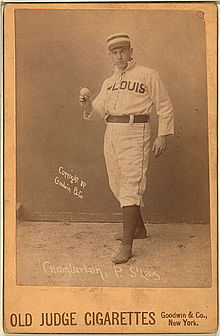
Elton P. "Ice Box" Chamberlain (November 5, 1867 – September 22, 1929) was an American professional baseball player. He played in the major leagues as a right-handed pitcher during 1886–1896. In several seasons, Chamberlain finished in his league's top ten in a number of pitching categories, including wins, earned run average, strikeouts, and shutouts. During one of his best seasons, the 1888 St. Louis Browns won the American Association pennant with a 92–43 record. Normally a right-handed pitcher, Chamberlain pitched the last two innings of an 1888 game with his left hand, making him a rare example of a switch pitcher.
Chamberlain finished his major-league baseball career with 264 complete games out of his 301 games started. After his playing days, he was hired as a baseball umpire and later announced he was becoming a boxer, but neither venture appears to have worked out. Not much is known about Chamberlain's later life. He died in Baltimore in 1929. (Full article...) -
Image 5

WSTR-TV (channel 64), branded Star 64 (stylized as STAR64), is a television station in Cincinnati, Ohio, United States, affiliated with MyNetworkTV. It is owned by Deerfield Media, which maintains a local marketing agreement (LMA) with Sinclair Broadcast Group, owner of dual CBS/CW affiliate WKRC-TV (channel 12), for the provision of advertising sales and other services. The two stations share studios on Highland Avenue in the Mount Auburn section of Cincinnati; WSTR's transmitter, Star Tower, is located in the city's College Hill neighborhood.
WSTR-TV began broadcasting in 1980 as WBTI, which broadcast a mix of commercial advertising-supported and subscription television (STV) programs. The STV programming was relegated into overnight hours (before being dropped altogether) at the start of 1985, making way for the station to become an independent station under the callsign WIII. After financial trouble, channel 64 stabilized under ABRY Communications before being purchased by Sinclair in 1996. It was briefly an affiliate of UPN before switching to The WB in 1998 and becoming part of MyNetworkTV in 2006. WKRC-TV produces dedicated morning and late evening newscasts for air on WSTR-TV. The station is one of Cincinnati's two ATSC 3.0 (NextGen TV) transmitters, serving the market's major commercial stations, which each broadcast some of WSTR-TV's subchannels on its behalf. (Full article...) -
Image 6
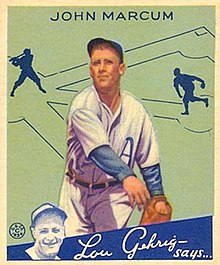
John Alfred Marcum (September 9, 1909 – September 10, 1984), nicknamed "Footsie" and "Moose", was an American professional baseball pitcher. He played for seven seasons in Major League Baseball (MLB) with the Philadelphia Athletics, Boston Red Sox, St. Louis Browns, and Chicago White Sox. Over seven seasons, he had a 65–63 record and a 4.66 earned run average (ERA).
Growing up in Kentucky, Marcum's professional career started after Bill Neal, the manager of the Louisville Colonels, saw him pitching and signed him to a contract. Marcum entered the major leagues late in the 1933 season with the Athletics, compiling a record of 3–2 in five appearances. He spent the next two years with the Athletics as one of their main starting pitchers, posting records of 14–11 in 1934 and 17–12 in 1935, a season in which he received votes for the American League Most Valuable Player. Before the 1936 season, Marcum was traded to the Red Sox, who were spending a great deal of money in hopes of improving. Marcum spent 1936–1938 with Boston, but he and other acquisitions failed to live up to expectations. After splitting 1939 between the Browns and the White Sox, Marcum pitched in the minor leagues for several more seasons before retiring. Following his baseball career, he returned to Kentucky, tending a 165-acre farm in Eminence. (Full article...) -
Image 7

Edward Nagle Williamson (October 24, 1857 – March 3, 1894) was an American professional baseball infielder in Major League Baseball. He played for three teams: the Indianapolis Blues of the National League (NL) for one season, the Chicago White Stockings (NL) for 11 seasons, and the Chicago Pirates of the Players' League for one season.
From 1883 and 1887, Williamson held the single-season record for both doubles and home runs. Although his record for doubles was surpassed in 1887, he held the home run record until 1919, when it was topped by Babe Ruth of the Boston Red Sox. Statistically, he was one of the best fielders of his era. During the first eight years of his career, he led the league at his position in both fielding percentage and double plays five times, and he also led his position in assists six times. Later, when he moved to shortstop, he again led the league in both assists and double plays. (Full article...) -
Image 8
Progressive Field is a baseball stadium in the downtown area of Cleveland, Ohio, United States. It is the ballpark of the Cleveland Guardians of Major League Baseball and, together with Rocket Mortgage FieldHouse, is part of the Gateway Sports and Entertainment Complex. It was ranked as MLB's best ballpark in a 2008 Sports Illustrated fan opinion poll.
The ballpark opened as Jacobs Field in 1994 to replace Cleveland Stadium, which the Guardians, then known as the Cleveland Indians, had shared with the Cleveland Browns of the National Football League. Since 2008, the facility has been named for Progressive Corporation, which purchased naming rights for $58 million over 16 years. The previous name came from team owners Richard and David Jacobs, who had acquired naming rights when the facility opened. The ballpark is still often referred to as "The Jake" based on its original name. The ballpark and arena are funded mainly by the passage of a sin tax in 1990 and both are owned by the Gateway Economic Development Corporation of Greater Cleveland, which is an appointed board of elected officials from the city of Cleveland and Cuyahoga County. (Full article...) -
Image 9Harry Edmund Bolick Jr. (October 29, 1912 – November 21, 1999) was an American athlete and sports coach. He played several sports at Presbyterian, and was best known for football: he was team captain and won the Jacobs Blocking Trophy in 1934. Bolick later coached several high schools in the area, as well as for one year the athletics at Erskine College. (Full article...)
-
Image 10
Paul Raymond "Shorty" Des Jardien (August 24, 1893 – March 7, 1956) was an American football, baseball and basketball player. He played for the University of Chicago where he was selected as the first-team All-American center in both 1913 and 1914 and also pitched a no-hitter for the baseball team. He later played professional baseball for the Cleveland Indians and professional football for the Cleveland Indians (1916), Hammond Pros (1919), Chicago Tigers (1920) and Minneapolis Marines (1922). He was inducted into the College Football Hall of Fame in 1955. (Full article...) -
Image 11

Roger Philip Bresnahan (June 11, 1879 – December 4, 1944), nicknamed "the Duke of Tralee", was an American player and manager in Major League Baseball (MLB). As a player, Bresnahan competed in MLB for the Washington Senators (1897), Chicago Orphans (1900), Baltimore Orioles (1901–02), New York Giants (1902–1908), St. Louis Cardinals (1909–1912) and Chicago Cubs (1913–1915). Bresnahan also managed the Cardinals (1909–1912) and Cubs (1915). He was a member of the 1905 World Series champions.
Bresnahan began his MLB career as a pitcher. He also served as an outfielder, before becoming a regular catcher. For his MLB career, Bresnahan had a .279 batting average in 4,480 at bats and a 328–432 managerial win–loss record. Bresnahan popularized the use of protective equipment in baseball by introducing shin guards, to be worn by catchers, in 1907. He also developed the first batting helmet. (Full article...) -
Image 12
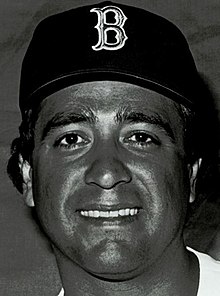
Michael Augustine Torrez (born August 28, 1946) is an American former Major League Baseball (MLB) starting pitcher. In an 18-season career, he pitched for the St. Louis Cardinals (1967–1971), Montreal Expos (1971–1974), Baltimore Orioles (1975), Oakland Athletics (1976–1977, 1984), New York Yankees (1977), Boston Red Sox (1978–1982), and New York Mets (1983–1984). As a member of the Yankees, he won two games of the 1977 World Series over the Los Angeles Dodgers. He batted and threw right-handed.
A native of Topeka, Kansas, Torrez was signed by the Cardinals in 1964. He made his MLB debut with them in 1967 and became a full-time major leaguer in 1969, winning nine of his final 10 starts that year. He had a 10–4 record in 1969 but an 8–10 record in 1970 before getting traded to the Expos during the 1971 season. After pitching one game for Montreal that year, Torrez spent the next three seasons with the ballclub, winning 16 games in 1972 and 15 games in 1974. Traded to the Orioles for 1975, he won 20 games for the only time in his career, posting a .690 winning percentage. The Orioles sent him to Oakland for 1976 as part of the Reggie Jackson trade; Torrez won 16 games for Oakland in 1976 before getting traded to the Yankees in April 1977. He reached the playoffs for the only time in his career that year, winning two World Series games as the Yankees defeated the Dodgers in six games. (Full article...) -
Image 13
Charles Wilber Rogan, also known as "Bullet Joe" (July 28, 1893 – March 4, 1967), was an American pitcher, outfielder, and manager for the Kansas City Monarchs in the Negro baseball leagues from 1920 to 1938. Renowned as a two-way player who could both hit and pitch successfully, one statistical compilation shows Rogan winning more games than any other pitcher in Negro leagues history and ranking fourth highest in career batting average. He was elected to the Baseball Hall of Fame in 1998.
Rogan's early baseball career took place in the U.S. Army, where he played for a famous team in the all-black 25th Infantry. After joining the Kansas City Monarchs, he was the top pitcher and one of the best hitters on a team that won three pennants from 1923 to 1925 and the 1924 Colored World Series. He became a playing manager in 1926 and led his team to another league title in 1929. (Full article...) -
Image 14

Arthur Albert Irwin (February 14, 1858 – July 16, 1921), nicknamed "Doc", "Sandy", "Cutrate" or "Foxy", was a Canadian-American shortstop and manager in Major League Baseball (MLB) during the late nineteenth century. He played regularly in the major leagues for eleven years, spending two of those seasons as a player-manager. He played on the 1884 Providence Grays team which won the first interleague series to decide the world champions of baseball. Irwin then served as a major league manager for several years.
Irwin occupied numerous baseball roles in the latter years of his career, having spent time as a college baseball coach, a major league scout and business manager, a minor league owner and manager, and a National League umpire. For most of Irwin's career, the collegiate and professional baseball schedules allowed him to hold positions at both levels in the same year. (Full article...) -
Image 15John "Pretzel" Pezzullo (December 10, 1910 – May 16, 1990) was a professional baseball player whose career spanned eight seasons, two of which were spent with the Major League Baseball (MLB) Philadelphia Phillies. Pezzullo, a pitcher, compiled an earned run average (ERA) of 6.36, allowing 61 earned runs off of 116 hits, five home runs, and 51 walks while recording 24 strikeouts over 861⁄3 innings pitched. Pezzullo also played in six seasons of minor league baseball. He made his MLB debut at the age of 24 after spending a season in the minor leagues for the New York Giants organization. Pezzullo earned the nicknamed "Pretzel" after his unusual pitching style. After retiring from baseball, Pezzullo moved to Dallas, Texas, where he died of cancer on May 16, 1990. (Full article...)
Did you know (auto-generated) - load new batch

- ... that Richard Worley played in minor baseball leagues and is now the commissioner of the Baltimore Police Department?
- ... that Larry Kennedy played professional baseball while serving as his town's mayor?
- ... that under a rules draft presented at the 1857 baseball convention, baseball bats would have been allowed to be shaved flat on one side?
- ... that thirty years after playing his first season for the Miami Hurricanes, J. D. Arteaga became the team's head coach in 2024?
- ... that the parents of Bob Glenalvin insisted that he play baseball under an assumed name?
- ... that baseball player Mark Littell developed an anatomically correct athletic cup called the "Nutty Buddy"?
- ... that the ownership group of San Diego's MLS team includes a Native American tribe and baseball player Manny Machado?
- ... that before Major League Baseball pitcher Keaton Winn was called up to the majors in June 2023, he had never been to a major league stadium?
Quotes
| The designated hitter rule is like letting someone else take Wilt Chamberlain's free throws.
— Rick Wise, St. Louis Cardinals starting pitcher, on the American League's 1973 implementation of a rule permitting another player to bat in place of a pitcher
|
 Featured lists - load new batch
Featured lists - load new batch
-
Image 1
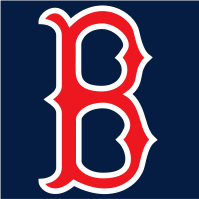
The Boston Red Sox are a Major League Baseball (MLB) team based in Boston, Massachusetts. From 1912 to the present, the Red Sox have played in Fenway Park. The "Red Sox" name originates from the iconic uniform feature. They are sometimes nicknamed the "BoSox", a combination of "Boston" and "Sox" (as opposed to the "ChiSox"), the "Crimson Hose", and "the Olde Towne Team". Most fans simply refer to them as the Sox.
One of the American League's eight charter franchises, the club was founded in Boston in 1901. They were a dominant team in the early 20th century, defeating the Pittsburgh Pirates in the first World Series in 1903. They won four more championships by 1918, and then went into one of the longest championship droughts in baseball history. Many attributed the phenomenon to the "Curse of the Bambino" said to have been caused by the trade of Babe Ruth to the New York Yankees in 1920. The drought was ended and the "curse" reversed in 2004, when the team won their sixth World Series championship. Championships in 2007 and 2013 followed. Every home game from May 15, 2003, through April 10, 2013, was sold out—a span of 820 games over nearly ten years. The team most recently won the World Series in 2018, the ninth championship in franchise history. (Full article...) -
Image 2
Liván Hernández, who has made a total of four Opening Day starts for the Expos/Nationals franchise.
The Washington Nationals are a Major League Baseball (MLB) franchise based in Washington, D.C. They play in the National League East division. The team was known as the Montreal Expos from 1969 to 2004. The first game of the new baseball season for a team is played on Opening Day, and being named the Opening Day starter is an honor, which is often given to the player who is expected to lead the pitching staff that season, though there are various strategic reasons why a team's best pitcher might not start on Opening Day. The Nationals have used six different Opening Day starting pitchers in their sixteen seasons. The six starters have a combined Opening Day record of 3 win, 9 losses and 4 no decisions. No decisions are awarded to the starting pitcher if the game is won or lost after the starting pitcher has left the game, or if the starting pitcher does not pitch at least five innings with the lead. The overall Opening Day record of the team is 7–9.
Max Scherzer holds the franchise record for most Opening Day starts with five. He is 1–3 on Opening Day, with one no decision. (Full article...) -
Image 3
Major League Baseball (MLB) annually honors its best relief pitchers in the American League (AL) and National League (NL) with the Mariano Rivera AL Reliever of the Year Award and Trevor Hoffman NL Reliever of the Year Award, respectively. The awards are named after former relievers Mariano Rivera and Trevor Hoffman, who played their entire careers in the respective leagues. First issued in 2014, the awards replaced the Delivery Man of the Year Award, which had been presented since 2005.
The Reliever of the Year Awards are based on the votes of a panel of retired relievers. Each voter selects three pitchers for each league based solely on their performance in the regular season; a 5-3-1 weighted point system is used to determine the winner. At its inception in 2014, the panel consisted of the top five relievers in career saves at the time—Rivera, Hoffman, Lee Smith, John Franco, and Billy Wagner—and the four living relief pitchers who were in the Hall of Fame: Dennis Eckersley, Rollie Fingers, Goose Gossage, and Bruce Sutter. (Full article...) -
Image 4

Bob Jamison, announcer from 1979 to 1990, won the Southern League Broadcaster of the Year Award in 1980 and 1982.
The Nashville Sounds Minor League Baseball team has played in Nashville, Tennessee, since being established in 1978 as an expansion team of the Double-A Southern League. They moved up to Triple-A in 1985 as members of the American Association before joining the Pacific Coast League in 1998. In 2021, they were placed in the Triple-A East, which became the International League in 2022. The team has employed seven play-by-play announcers who have provided running commentary for their games' radio broadcasts on fourteen radio stations throughout their history.
As of 2024, all Sounds home and road games are broadcast on WBUZ-HD3 94.9 FM (AM 830). Live audio broadcasts are also available online through the team's website and the MiLB First Pitch app. Games can be viewed through the MiLB.TV subscription feature of the official website of Minor League Baseball, with audio provided by a radio simulcast. (Full article...) -
Image 5
The Chicago White Sox celebrate after defeating the Minnesota Twins 1–0 to win the 2008 American League Central.
A tie-breaker was required in Major League Baseball (MLB) when two or more teams were tied at the end of the regular season for a postseason position such as a league pennant (prior to the introduction of the League Championship Series in 1969), a division title, or a wild card spot. Until 2022, both the American League (AL) and the National League (NL) used a one-game playoff format for tie-breakers, although the NL used a best-of-three series prior to 1969, when the leagues were split into divisions. As these tie-breaker games counted as part of the regular season and MLB teams (American League beginning in 1961, and National League beginning in 1962) have 162-game regular season schedules, the tie-breaker games were sometimes referred to as "Game 163". In 2022, as part of the new Collective Bargaining Agreement to end the 2021–22 Major League Baseball lockout, tiebreaker games were replaced with statistical tiebreaker procedures.
Sixteen tie-breakers – 12 single-game and four series – have been played in MLB history. In baseball statistics, tie-breaker games counted as regular season games with all events in them counted towards regular season statistics. This had implications on statistical races, such as when Matt Holliday won the batting average and runs batted in titles thanks in part to his performance in the 2007 tie-breaker. Home-field advantage for tie-breakers was determined by a coin flip through the 2008 season, after which performance-based criteria, starting with head-to-head record of the tied teams, were put in place. (Full article...) -
Image 6

Jewish players have played in Major League Baseball since the league came into existence in the late 19th century, and have a long and storied history within the game. There have been 190 players who identified as Jewish during their Major League career, including players who converted during or before their careers, and players who have or had at least one Jewish parent, and identified as Jewish by virtue of their parentage.
In the early years, Jewish baseball players faced constant antisemitic heckles from opponents and fans, with many hiding their heritage to avoid discrimination in the league. Despite this, a number of Jewish players overcame such abuse and went on to become stars. Two such players, Hank Greenberg and Sandy Koufax, were both elected to the Baseball Hall of Fame and are widely considered to be amongst the most important and iconic players in baseball and American history. The sport played a large part in the assimilation of American Jews into American society at a time of rampant antisemitism, and remains a very important part in Jewish American culture today. (Full article...) -
Image 7On November 17, 1992, during the 1992–93 offseason, Major League Baseball (MLB) held an expansion draft in New York City to allow two expansion teams, the Florida Marlins and Colorado Rockies, to build their rosters prior to debuting in the National League's (NL) East and West divisions, respectively, in the 1993 MLB season.
The 1990 collective bargaining agreement between MLB owners and the MLB Players Association allowed the NL to expand by two members to match the American League (AL). In June 1991, MLB accepted bids of groups from Miami, Florida, and Denver, Colorado, with debuts set for 1993. (Full article...) -
Image 8

Mike Mussina (1990) made five all-star appearances with the Orioles.
The Baltimore Orioles are a Major League Baseball (MLB) franchise based in Baltimore, Maryland. They play in the American League East division. Since the institution of MLB's Rule 4 Draft, the Orioles have selected 60 players in the first round. Officially known as the "First-Year Player Draft", the Rule 4 Draft is MLB's primary mechanism for assigning amateur baseball players from high schools, colleges, and other amateur baseball clubs to its teams. The draft order is determined based on the previous season's standings, with the team possessing the worst record receiving the first pick. In addition, teams which lost free agents in the previous off-season may be awarded compensatory or supplementary picks.
Of the 60 players picked in the first round by Baltimore, 30 have been pitchers, the most of any position; 21 of them were right-handed, while 9 were left-handed. Twelve outfielders, eight shortstops, seven catchers, two third basemen, and one second basemen were also taken. The team has never drafted a player at first base. 16 of the players came from high schools or universities in the state of California, and Florida follows with five players. The Orioles have also drafted two players from Canada, Ntema Ndungidi (1997) and Adam Loewen (2002). The Orioles have not drafted any players from their home state of Maryland. (Full article...) -
Image 9

Camden Yards has been the Orioles' home ball park since 1992.
The Baltimore Orioles are a Major League Baseball (MLB) franchise based in Baltimore, Maryland. They play in the American League East division. The Orioles started playing in Baltimore in 1954, after moving from St. Louis, where they were known as the St. Louis Browns. The first game of the new baseball season for a team is played on Opening Day, and being named the Opening Day starter is an honor, which is often given to the player who is expected to lead the pitching staff that season, though there are various strategic reasons why a team's best pitcher might not start on Opening Day. The Orioles have used 33 different Opening Day starting pitchers in their 60 seasons since moving to Baltimore. The 33 starters have a combined Opening Day record of 22 wins, 18 losses and 17 no decisions. No decisions are only awarded to the starting pitcher if the game is won or lost after the starting pitcher has left the game.
The first Opening Day for the Orioles was played in Detroit against the Detroit Tigers on April 13, 1954. Don Larsen was the Orioles' Opening Day starting pitcher that day, in a game the Orioles lost 3–0. Jim Palmer and Mike Mussina have made the most Opening Day starts for the Baltimore Orioles, with six apiece. Palmer has a record of five wins and one loss in his Opening Day starts, and Mussina has a record of three wins, two losses and one no decision. Dave McNally made five Opening Day starts for the Orioles, with a record of three wins and no losses. Other Oriole pitchers who have made multiple Opening Day starts are Steve Barber, Rodrigo López, and Jeremy Guthrie, with three apiece, and Milt Pappas, Dennis Martínez, Mike Flanagan, Mike Boddicker, and Rick Sutcliffe, with two apiece. Flanagan's two Opening Day starts occurred eight years apart, in 1978 and 1986. (Full article...) -
Image 10
The All-Star Final Vote was an annual Internet and text message ballot by Major League Baseball (MLB) fans to elect the final player for each team that participates in the Major League Baseball All-Star Game, after all other selections were made and announced. The first 33 players were selected by a combination of procedures. The sponsorship changed annually, but the contest remained similar from year to year. Each league presented a five-man ballot and gave the fans a few days to choose one final All-Star. This process was used from 2002 through 2018. (Full article...) -
Image 11
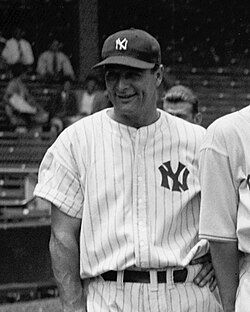
Lou Gehrig briefly held the single-season RBI record with his 175 in 1927 before Hack Wilson topped this total with 191 in 1930. In total Gehrig was responsible for three of the nine seasons in which a player hit 170 or more RBI.
In baseball, a run batted in (RBI) is awarded to a batter for each runner who scores as a result of the batter's action, including a hit, fielder's choice, sacrifice fly, bases loaded walk, or hit by pitch. A batter is also awarded an RBI for scoring himself upon hitting a home run. However, if a run scores because of an error that the defense commits on a batted ball, the batter does not (in most cases) receive an RBI; the exception is when the official scorer deems the run would've scored with or without an error, such as when an error occurs on a fielder's choice.
In Major League Baseball (MLB), a player in each league[L] wins the "RBI crown" or "RBI title" each season by hitting the most runs batted in that year. The first RBI champion in the National League (NL) was Deacon White; in the league's inaugural 1876 season, White hit 60 RBIs for the Chicago White Stockings. The American League (AL) was established in 1901, and Hall of Fame second baseman Nap Lajoie led that league with 125 RBIs for the Philadelphia Athletics. Over the course of his 27-season career, Cap Anson led the NL in RBI eight times. Babe Ruth and Honus Wagner have the second- and third-most RBI titles, respectively: Ruth with six, and Wagner with five. Several players are tied for the most consecutive seasons led with three: Anson (twice), Ty Cobb, Rogers Hornsby, Ruth, Joe Medwick, George Foster, and Cecil Fielder. Notably, Matt Holliday won the NL title in 2007 by one RBI over Ryan Howard, only overtaking Howard due to his performance in the 2007 National League Wild Card tie-breaker game. Had Howard won the 2007 title, he would have led the NL in a record four consecutive seasons from 2006 to 2009. The most recent champions are Kyle Tucker in the American League, and Matt Olson in the National League. (Full article...) -
Image 12Jackie Robinson, the inaugural winner in 1947 and eventual namesake of the award
In Major League Baseball, the Rookie of the Year Award is given annually to two outstanding rookie players, one each for the American League (AL) and National League (NL), as voted on by the Baseball Writers' Association of America (BBWAA). The award was established in 1940 by the Chicago chapter of the BBWAA, which selected an annual winner from 1940 through 1946. The award became national in 1947; Jackie Robinson, the Brooklyn Dodgers' second baseman, won the inaugural award. One award was presented for all of MLB in 1947 and 1948; since 1949, the honor has been given to one player each in the NL and AL. Originally, the award was known as the J. Louis Comiskey Memorial Award, named after the Chicago White Sox owner of the 1930s. The award was renamed the Jackie Robinson Award in July 1987, 40 years after Robinson broke the baseball color line.
Nineteen players have been elected to the National Baseball Hall of Fame—Robinson, seven AL players, and eleven others from the NL. The award has been shared twice: once by Butch Metzger and Pat Zachry of the NL in 1976; and once by John Castino and Alfredo Griffin of the AL in 1979. Members of the Brooklyn and Los Angeles Dodgers have won the most awards of any franchise (with 18), twice the total of the New York Yankees, and members of the Philadelphia and Oakland Athletics (eight), who have produced the most in the AL. Fred Lynn and Ichiro Suzuki are the only two players who have been named Rookie of the Year and Most Valuable Player in the same year, and Fernando Valenzuela is the only player to have won Rookie of the Year and the Cy Young Award in the same year. Sam Jethroe is the oldest player to have won the award, at age 32, 33 days older than 2000 winner Kazuhiro Sasaki (also 32). Gunnar Henderson of the Baltimore Orioles and Corbin Carroll of the Arizona Diamondbacks are the most recent winners. (Full article...) -
Image 13The Marvin Miller Man of the Year Award is given annually to a Major League Baseball (MLB) player "whose on-field performance and contributions to his community inspire others to higher levels of achievement." The award was created by the Major League Baseball Players' Association (MLBPA) and was presented to the inaugural winner – Mark McGwire – in 1997 as the "Man of the Year Award". Three years later, it was renamed in honor of Marvin Miller, the first executive director of the MLBPA. The award forms part of the Players Choice Awards.
In order to determine the winner, each MLB team nominates one of their players, who is selected by their teammates to appear on the ballot. An online vote is conducted among baseball fans in order to reduce the number of candidates to six. MLB players then choose the award winner from among the six finalists. In addition to the award, recipients have $50,000 donated on their behalf to charities of their choice by the MLB Players Trust. John Smoltz, Jim Thome, Michael Young, Curtis Granderson, and Marcus Semien are the only players to win the Marvin Miller Man of the Year Award on multiple occasions. Five winners – Paul Molitor, Jim Thome, Smoltz, Chipper Jones and Mariano Rivera – are members of the National Baseball Hall of Fame. (Full article...) -
Image 14Warren Spahn in 1953
The Warren Spahn Award is presented each season by the Oklahoma Sports Hall of Fame to the best left-handed pitcher in Major League Baseball (MLB). The award is named after Warren Spahn, who holds the MLB record in wins for a left-handed pitcher with 363. The Warren Spahn Award was created in 1999 by Richard Hendricks, the founder of the Territorial Capital Sports Museum, formerly Oklahoma Sports Museum, to honor Spahn, who resided in Oklahoma. The award was formerly presented at the Masonic Temple in Guthrie, Oklahoma until 2009, when the Oklahoma Sports Hall of Fame was granted ownership of the award, in partnership with the Bricktown Rotary Club. From 2009-2019, the award was presented at the annual Warren Spahn Award Gala, hosted by the Bricktown Rotary Club of Oklahoma City. Currently, the Oklahoma Sports Hall of Fame presents each annual award to the winner during season play at their respective team's ballpark.
The award has been won by 14 different pitchers. The winner is chosen based on rankings, which are based on wins, strikeouts, and earned run average. The most recent recipient is Blake Snell of the San Diego Padres. Randy Johnson received the first four awards from 1999 through 2002. He attended the awards ceremony due to his respect for Spahn, who called him personally to ask him to attend. CC Sabathia (2007–2009), Johan Santana (2004, 2006), Clayton Kershaw (2011, 2013, 2014, 2017), and Blake Snell (2018, 2023) are also multiple Warren Spahn Award winners. Johnson (1999–2002), Santana (2004, 2006), Sabathia (2007) and Kershaw (2011, 2013, 2014), and Snell (2018, 2023) also won the Cy Young Award, given annually to the best pitcher in each league, in years they won the Warren Spahn Award.
Santana (2004, 2006), Sabathia (2007), Kershaw (2011, 2013, 2014), and Keuchel (2015) won the Pitcher of the Year Award, given annually to the most outstanding pitcher in each league, in years they won the Warren Spahn Award. (Full article...) -
Image 15

Keith Hernandez won eleven consecutive Gold Gloves at first base, the most by any MLB player.
The Gold Glove Award is the award given annually to the Major League Baseball players judged to have exhibited superior individual fielding performances at each fielding position in both the National League (NL) and the American League (AL), as voted by the managers and coaches in each league. Managers are not permitted to vote for their own players. Eighteen Gold Gloves are awarded each year (with the exception of 1957, 1985, 2007 and 2018), one at each of the nine positions in each league. In 1957, the baseball glove manufacturer Rawlings created the Gold Glove Award to commemorate the best fielding performance at each position. The award was created from a glove made from gold lamé-tanned leather and affixed to a walnut base. Initially, only one Gold Glove per position was awarded to the top fielder at each position in the entire league; however, separate awards were given for the National and American Leagues beginning in 1958.
Keith Hernandez has won the most Gold Gloves at first base, capturing 11 consecutive awards in the National League from 1978 to 1988. In the American League, Don Mattingly won nine times with the New York Yankees for the second-highest total among first basemen, and George Scott won eight awards playing for the Boston Red Sox (three) and the Milwaukee Brewers[a] (five). Vic Power[b], and Bill White each won seven awards; six-time winners include Wes Parker and J. T. Snow. Mark Teixeira has won five Gold Gloves at the position. Gil Hodges, Eddie Murray and Jeff Bagwell are the only members of the Baseball Hall of Fame to have won a Gold Glove at first base. (Full article...)
More did you know
- ... that despite its author keeping detailed journals of his experiences, the baseball memoir Odd Man Out was criticized by many people named in the book as being factually inaccurate?
- ... that the longest extra inning game in professional baseball history was an International League game that lasted 33 innings?
- ... that two members of the $100,000 infield have been inducted into the Baseball Hall of Fame?
- ... that three of the four batters faced by Mike Palagyi in his one Major League game were later inducted into the Baseball Hall of Fame?
- ... that Boston Red Sox third baseman Will Middlebrooks is engaged to a former Dallas Cowboys cheerleader whom he has known since childhood?
Sports portals
Selected picture
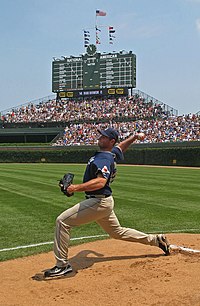
| Credit: User:TonyTheTiger |
Christopher Ryan Young (born May 25, 1979, in Dallas) is a starting pitcher for the San Diego Padres of Major League Baseball. He made his major league debut on August 24, 2004, for the Texas Rangers. He had previously excelled in basketball and baseball at Highland Park High School in University Park, Texas and Princeton University.
Associated Wikimedia
The following Wikimedia Foundation sister projects provide more on this subject:
-
Commons
Free media repository -
Wikibooks
Free textbooks and manuals -
Wikidata
Free knowledge base -
Wikinews
Free-content news -
Wikiquote
Collection of quotations -
Wikisource
Free-content library -
Wikiversity
Free learning tools -
Wiktionary
Dictionary and thesaurus
More portals
- Portals with triaged subpages from June 2018
- All portals with triaged subpages
- Portals with no named maintainer
- Automated article-slideshow portals with 51–100 articles in article list
- Automated article-slideshow portals with 501–1000 articles in article list
- Random portal component with 41–50 available subpages
- Automated article-slideshow portals with 201–500 articles in article list
- Random portal component with 11–15 available subpages
- Random portal component with 21–25 available image subpages





